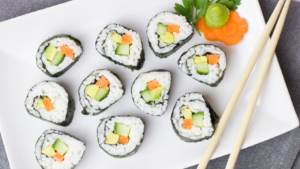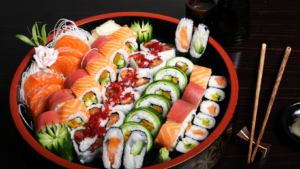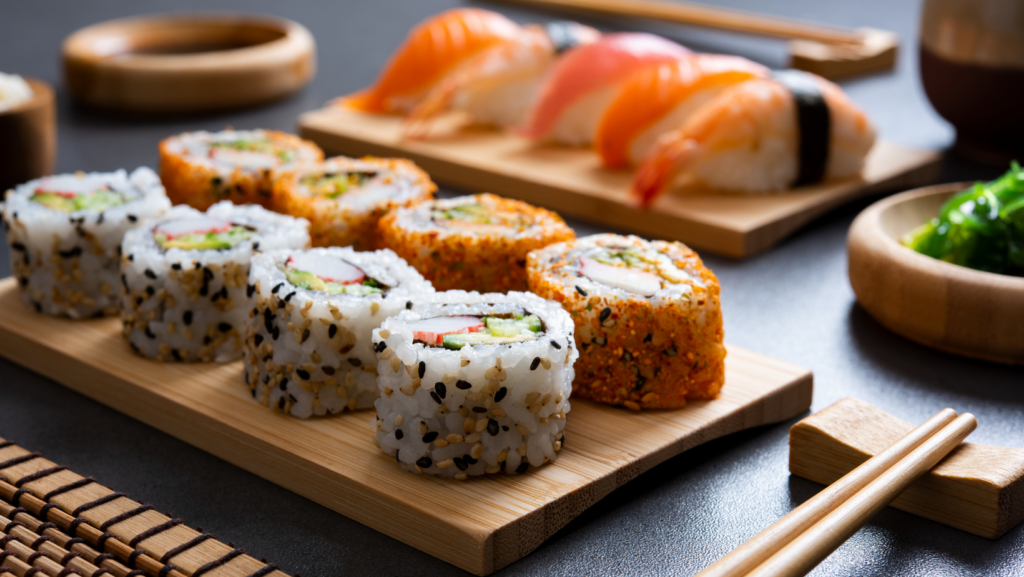Sushi, a culinary delight from the land of the rising sun, has been making waves globally for its unique flavors and health benefits. But did you know there’s a new trend on the horizon? Enter wellness sushi, a fusion of traditional Japanese cuisine and modern nutritional science.
This innovative concept is all about combining the aesthetic appeal and taste of sushi with a health-centric approach. It’s not just about indulging your taste buds, but also nourishing your body with essential nutrients. Stay tuned as we unravel the magic behind wellness sushi, its benefits, and why it’s quickly becoming a favorite among health-conscious foodies worldwide.
From the most sumptuous rolls to the freshest ingredients, we’re set to embark on an exciting journey into the world of wellness sushi. So, are you ready to roll?
Wellness Sushi

Diving deeper into the concept of wellness sushi, we encounter the idea behind this culinary innovation and unravel its significance in daily diet.
Wellness sushi emerges as a result of East meeting West. It’s a mélange of traditional Japanese sushi techniques and the Western perspective on balanced diet and wellness. Instead of merely being a delicious delight, wellness sushi takes it a step further. The preparation incorporates ingredients rich in antioxidants, fiber, and essential fatty acids.
Artful and Healthy Sushi Making Techniques
Mastering the art of sushi making is intrinsic in the rise of wellness sushi. This section sheds light on the equilibrium between taste and nutrition, and the significance of hygiene and safety in sushi making.
Balancing Taste and Nutrition

Effective sushi making, particularly for wellness sushi, requires a delicate balance. The chef must harmonize taste and nutrition, creating a dish that’s both flavorful and nourishing. A key technique involves the use of premium ingredients like protein-rich salmon and omega-3 packed tuna. Variety in these nutrient-dense components, like incorporation of plant-based proteins, can also enhance the dietary value.
Equally important is maintaining sushi’s iconic taste. Sushi chefs employ various techniques to emphasize flavors. Marinating fish, for instance, can enhance the taste and provide a depth of flavor. Seaweed, known for its health benefits, also contributes distinct flavors, as do wasabi and ginger. The result is a tasty sushi roll, brimming with nutritional benefits.
Hygiene and Safety in Sushi Making
Hygiene and safety play a vital role in overall sushi making, especially in the preparation of ingredients. High standards of hygiene ensure the sushi doesn’t breed bacteria, thereby preventing foodborne illnesses. Using fresh ingredients is a key hygiene practice in sushi making. For example, sushi chefs only use high-quality fish from reputable sources, discarding any product that does not meet their standards.
Safety measures in sushi making extend to the preparation process as well. It’s common for sushi chefs to wear gloves during preparation, adding another layer of protection. Furthermore, maintaining proper temperature during storage and preparation of ingredients—particularly fish—preserves the freshness and prevents bacterial growth.
Through these robust hygiene and safety practices, wellness sushi chefs can deliver a high-quality, nutritious, and safe product to health-conscious sushi lovers.
Sourcing Wellness Sushi Responsibly
To further appreciate the art of wellness sushi, it’s crucial to consider the source of the ingredients. Additionally, understanding dining etiquette enhances the overall experience. This section delves into these two central aspects.
Supporting Sustainable Seafood for Sushi

Sustainability forms the cornerstone of wellness sushi, specifically with regard to seafood sourcing. Overfishing strains our oceans, negatively affecting the vast marine biodiversity. Sustainable seafood — responsibly sourced and carefully managed to maintain robust fish populations — marks a proactive response to this issue. When dining out or creating sushi at home, consumers have the power to support this vital movement.
Selecting sushi restaurants that commit to sustainable sourcing acts as a practical first step. Such establishments typically display their commitment via their menus, websites, or upon inquiry. For home chefs, purchasing seafood from vendors aligned with sustainability, such as those certified by the Marine Stewardship Council (MSC), extends this commitment. Essentially, choosing sushi that incorporates sustainable seafood doesn’t only satiate your palate, it also serves as a conscious gesture preserving our oceans.

